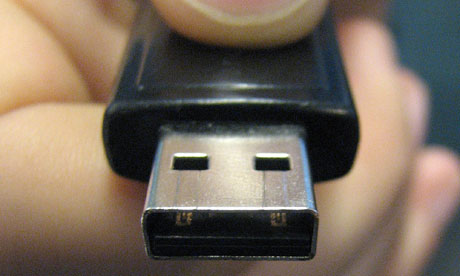'I keep sensitive passwords, account numbers, pin numbers etc on a small USB drive. Is there a big flaw in my system?' Photograph: Matthew Baker/PA
My 16-year-old wants a netbook/mini-laptop for his sixth form schoolwork, and it needs to be fast enough to handle Word documents in Microsoft Office. He already has a laptop, but it's too bulky and too heavy to take to school. The price is a concern but I really want him to be happy with it.
Sarah
I thought this would be easy because I'd seen the Samsung 305U mini-laptop being sold off for around £300. It has now been discontinued, but you could try to pick one up by searching for Samsung 305U or even NP305U1A-A01UK.
Netbooks are limited by their screen resolution (1024 x 600 pixels), which is below the specification needed for Microsoft Windows 8. Other drawbacks include having only 1GB of memory, and running Windows 7 Starter. The Samsung 305U is about the same size as a netbook, having an 11.6in screen and weighing 1.21kg. However, it has better graphics, better screen resolution (1366 x 768 pixels), much more memory (4GB), and a much better operating system (64-bit Windows 7 Home Premium).
The drawback with the Samsung 305U and similar cheap mini-laptops is that they usually have an AMD Fusion E-450 processor. This is much slower than a low-end laptop chip such as the Intel Pentium B830, though still a bit faster than the sort of Intel Atom you would get in a netbook. Still, the E-450 can certainly run Microsoft Word.
The Lenovo IdeaPad S205 is an excellent alternative to the Samsung 305U and has an almost identical specification for £309 from Laptops Direct.
In some mini-laptops, such as the Lenovo IdeaPad S206, the E-450 has been replaced by AMD's E2-1800. This looks like the same chip with the clock speed bumped up from 1.65GHz to 1.70GHz, which makes no practical difference.
The next step up would be something like an Asus X401A, which is also available for around £300. This gets you a much faster processor such as the Intel Pentium B980 (avoid the Pentium B830 version, which is much slower), and the choice of Windows 7 or Windows 8. However, the X401A has a 14in screen and weighs 1.85kg, so it's bigger, heavier and much less portable than mini-laptops like the Samsung 305U and IdeaPad S205.
Note: After shopping around, Sarah bought her son an 11.6in HP Pavilion dm1-4341sa mini-laptop with an E2-1800 processor and Windows 7 for £279. HP's current price is £329 with Windows 8 installed.

No comments:
Post a Comment